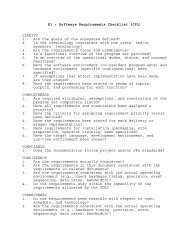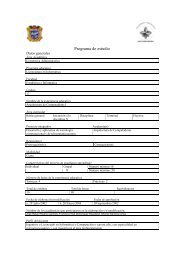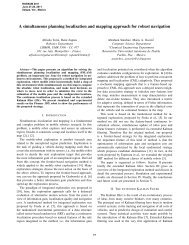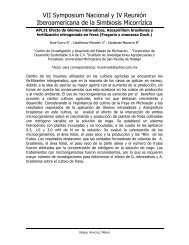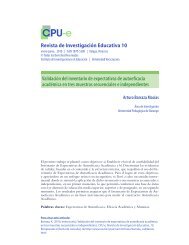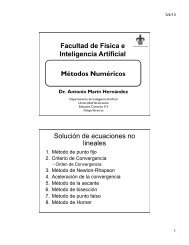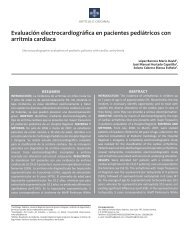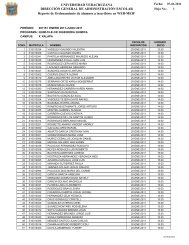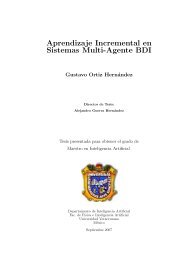Suplemento 2 Vol 8 No 1.indd - Universidad Veracruzana
Suplemento 2 Vol 8 No 1.indd - Universidad Veracruzana
Suplemento 2 Vol 8 No 1.indd - Universidad Veracruzana
Create successful ePaper yourself
Turn your PDF publications into a flip-book with our unique Google optimized e-Paper software.
in anesthesia mechanisms. It is likely that some neural<br />
networks used to keeping us awake are necessary to wake<br />
us up from anesthesia. Additionally, anesthetics can cause<br />
sleep with direct administration into brain nuclei known<br />
to regulate sleep, and endogenous neuromodulators known<br />
to regulate sleep also alter anesthetic action 2 . Studies have<br />
shown experimental evidence of a relationship between<br />
the degree of prior sleep deprivation and the anesthesia<br />
potency, and also about the dissipative effect of anesthesia<br />
on sleep debt 4 . All these findings highlight more similarities<br />
between sleep and anesthesia than earlier investigation<br />
have considered.<br />
The electroencephalogram (EEG) shows<br />
characteristic temporal patterns under different anesthetic<br />
conditions. A burst suppression pattern appears during<br />
deep isoflurane anesthesia, where high amplitude bursts are<br />
followed by periods of nearly silent (EEG) 5.<br />
Spindle oscillations ranging between 12 to 14 Hz<br />
recur periodically in the thalamus and cortex during sleep 6,7 .<br />
The hyperpolarization of thalamocortical neurons caused<br />
by the recurrent inhibitory circuit in the reticular thalamus<br />
induces spindles over most of the cortex 8 . Sleep spindles<br />
might be the electrical result of inhibitory neuronal firing<br />
gating synaptic transmission through the thalamus to avoid<br />
sleep disruption 7 . K-complex is a negative-positive complex<br />
with a latency ranging from 100 to 250 ms post-stimulus,<br />
which can be recorded from the human scalp in response to<br />
various external stimuli. In humans, k -complexes occur in<br />
stages 2, 3 and 4 of nrem sleep 9 .<br />
We found spontaneous and stimulus-evoked bursts<br />
during deep isoflurane anesthesia in rats. The burst activity<br />
during anesthesia contains waves of high amplitude and a<br />
predominant 10 Hz frequency (Fig. 1). The burst activity<br />
shares at least two important characteristics with sleep<br />
spindles and k-complexes: it can be evoked by external<br />
stimulation during unconsciousness states, and has a<br />
predominant 10 Hz frequency waves. Since the brain<br />
retains the ability to respond to external stimuli during<br />
deep anesthesia, in a form of bursts, we hypothesize<br />
that there is a common neuronal generator and perhaps<br />
similar neurophysiological meaning for sleep spindles,<br />
k-complexes, and anesthesia bursts. If so, burst activity<br />
during deep anesthesia might be a potential experimental<br />
Revista Médica<br />
model to study somatosensory processing during sleep.<br />
Figure 1. Burst shape. The superimposed traces in the top panel show examples<br />
of bursts at 2% [isof]. The bottom trace is the average of evoked burst responses<br />
(n=552) at 2% [isof]. During anesthetized conditions a high-amplitude response<br />
appears 250 ms after the auditory stimulus. The appearance of individual bursts<br />
resembles the shape of a sleep spindle, while the average of multiple bursts looks<br />
like a K-complex.<br />
BIBLIOGRAFÍA<br />
1. Harrisson NL. General anesthesia research:<br />
aroused from a deep sleep?. Nature neuroscience.<br />
2002;5(10): 928-929.<br />
2. Allada R. An emerging link between general<br />
anesthesia and sleep. PNAS 2008; 105(7): 2257–<br />
2258.<br />
3. Rojas MJ, Navas JA, Rector DM. Evoked Response<br />
Potential Markers for Anesthetic and Behavioral<br />
States. Am J Physiol Regul Integr Comp Physiol.<br />
2006; 291(1): R189-96..<br />
4. Tung A, Mendelson WB. Anesthesia and sleep.<br />
Sleep Medicine Reviews 2004; 8: 213–225.<br />
5. Hartikainen K, Rorarius MG. Cortical responses to<br />
auditory stimuli during isoflurane burst suppression<br />
anaesthesia. Anaesthesia. 1999; 54(3): 210-4.<br />
6. Contreras D, Destexhe A, Sejnowski TJ, Steriade<br />
M. Spatiotemporal patterns of spindle oscillations<br />
in cortex and thalamus. 1997; 17(3): 1179-96.<br />
7. Cote KA, Epps TM, Campbell KB. The role of the<br />
spindle in human information processing of highintensity<br />
stimuli during sleep. J. Sleep Res. 2000;<br />
9: 19-26.<br />
8. Steriade M, Amzica F. Sleep oscillations developing<br />
Revista Médica de la <strong>Universidad</strong> <strong>Veracruzana</strong> / <strong>Suplemento</strong> 2 <strong>Vol</strong>. 8 núm. 1, Enero - Junio 2008 69



